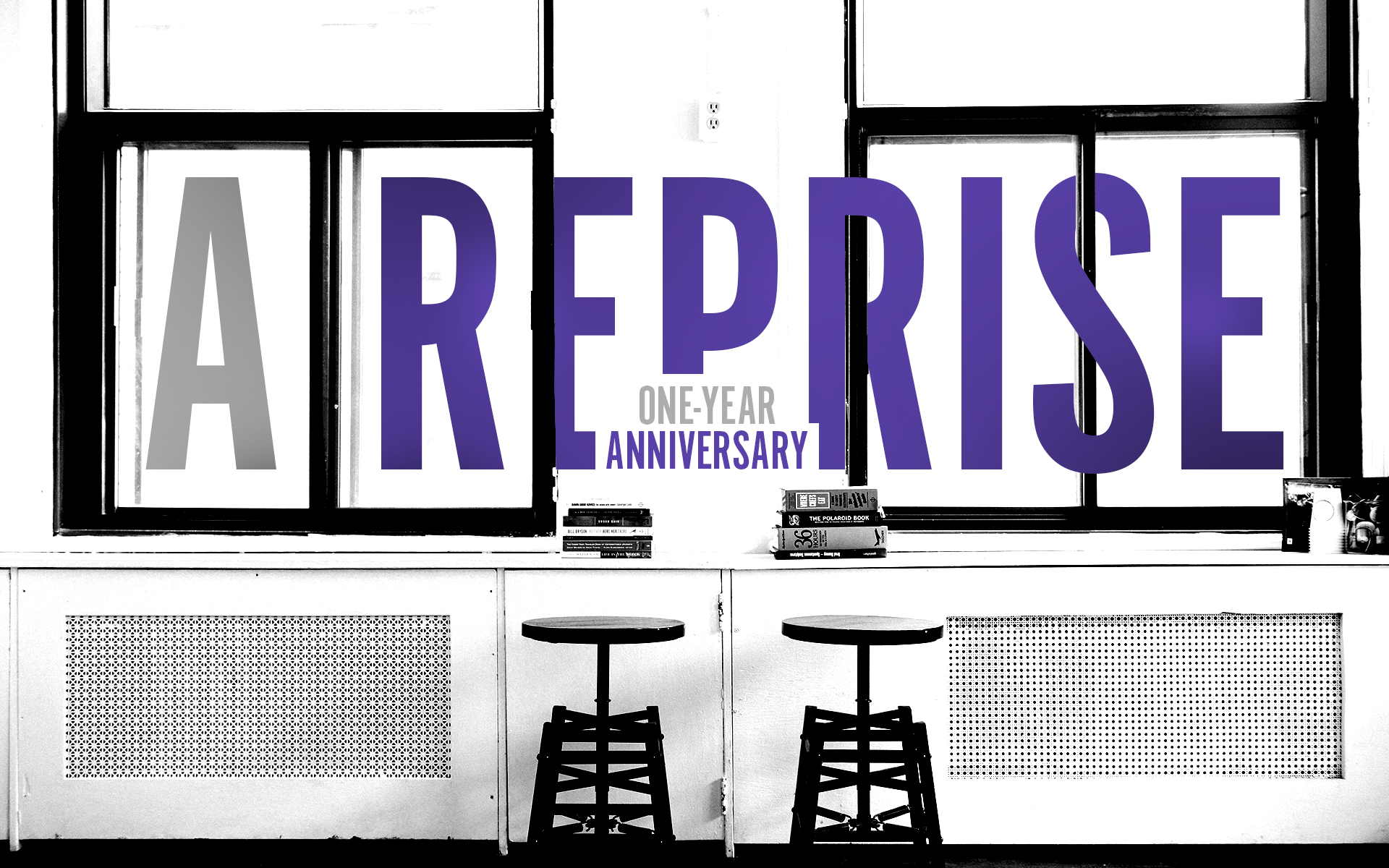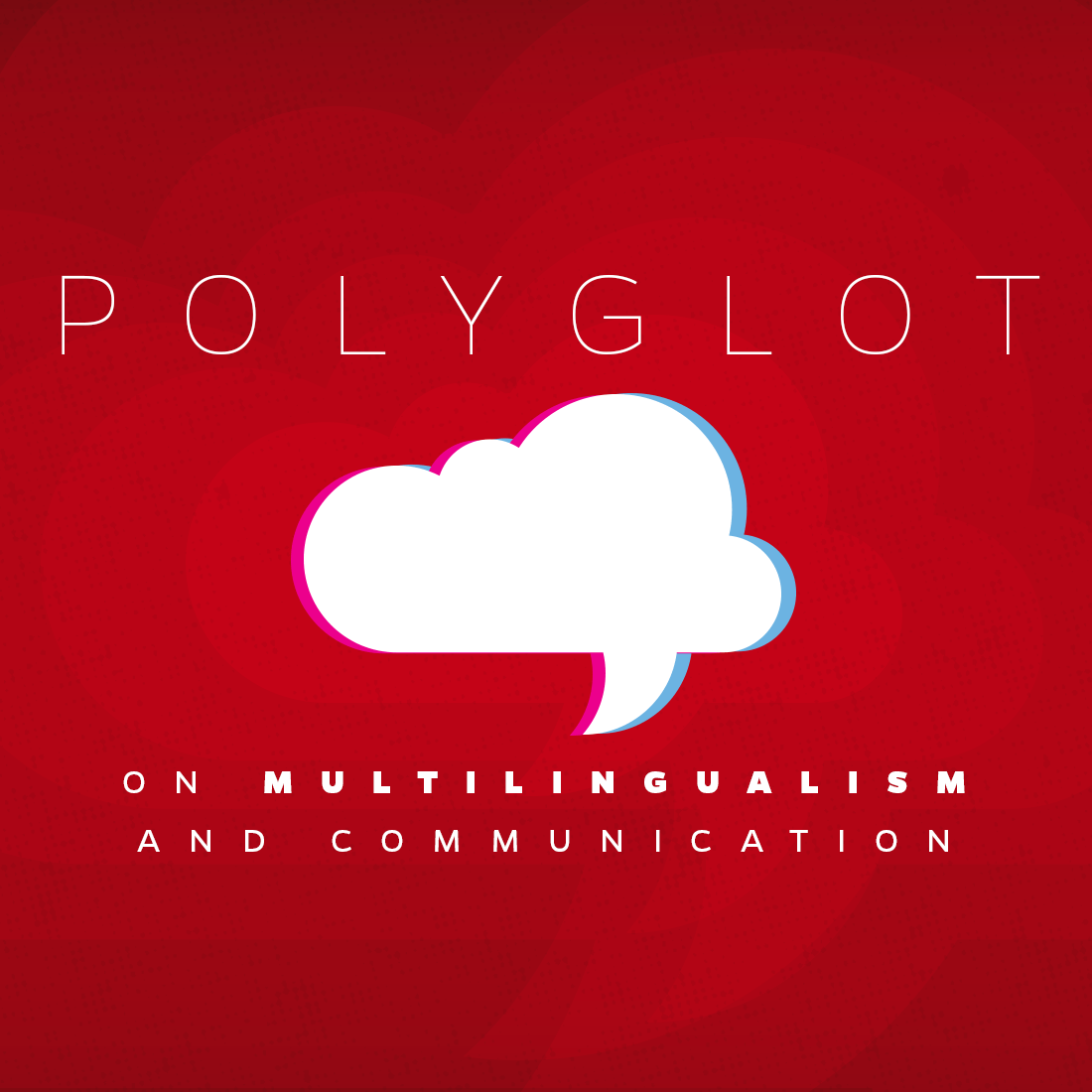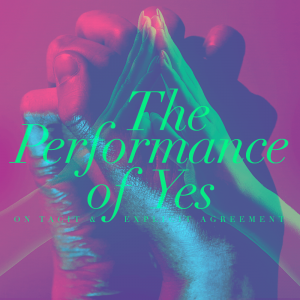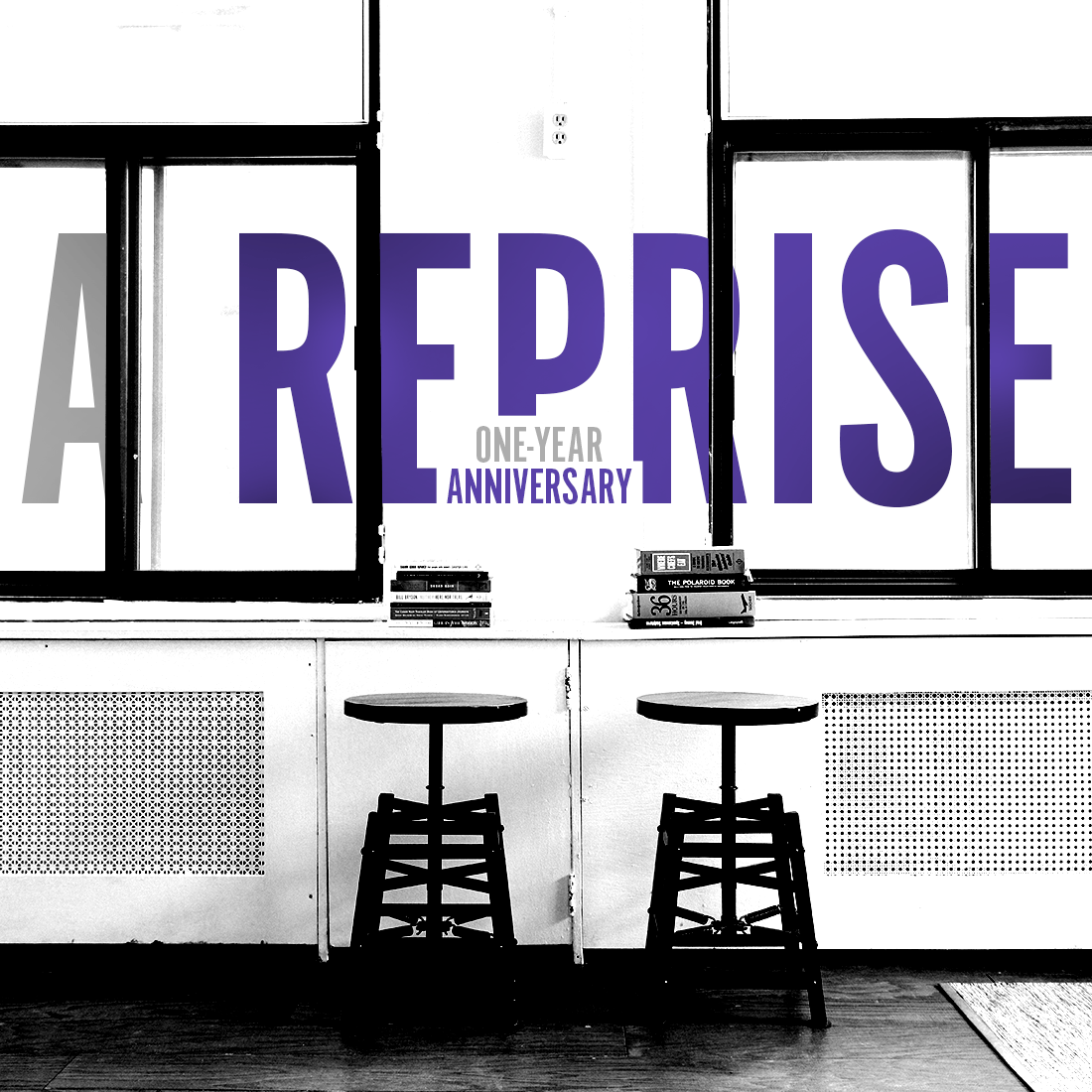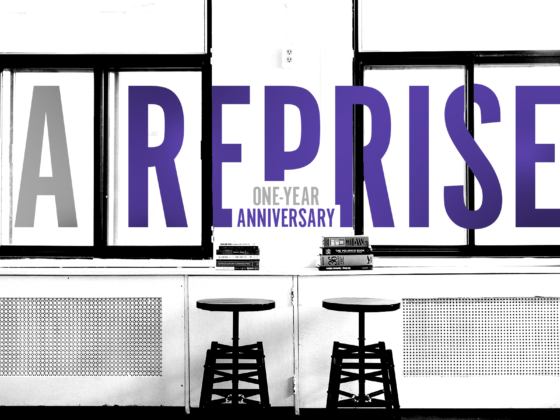JOE MADSEN
Modern Irish history is nothing if not a reprise.
For more than a century, as the island has set itself apart from British dominion, its people have undergone all manner of revival, ushering in a future founded on ancient tradition. Ireland today lauds its cultural pillars as handed down through centuries, pinning its identity to an aged reverence, with Irish language, athletics, and politics all grounded on being timelessly sacrosanct. Yet resurrecting these cornerstones is still a fresh process. Only the previous century and a half have seen them return to new vigor, and the aim of reviving them strives to be a counterbalance to a former age’s sheer desolation, plagued by death, disease, and division. From a 19th-century era, when Irish unity and identity fell to an abysmal low, leaders at each layer of the populace found a need to reclaim Irishness and reforge societal bonds. A new nationalism found its footing.
The signs of a steadily more unified, more modernized Ireland are in place.
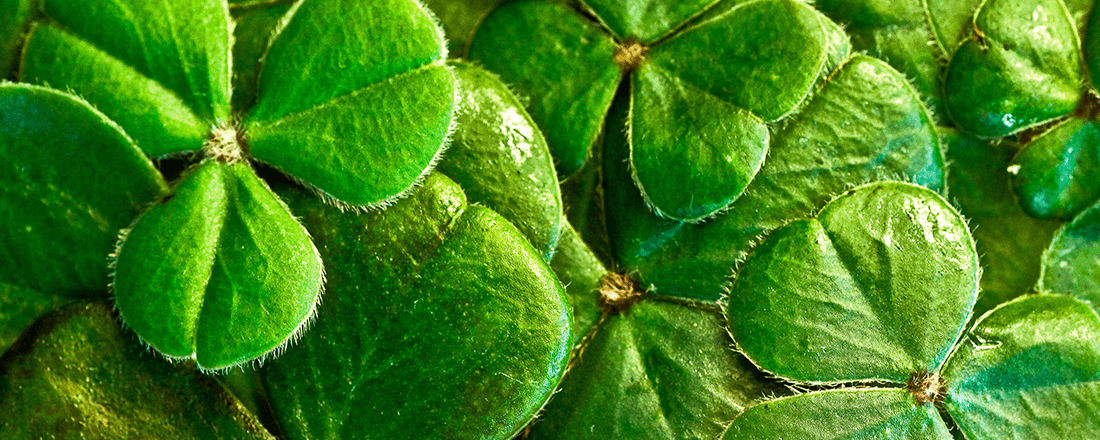
Fledgling thought it was, it showed itself in many faces, as politics pondered Irish independence, young people competed in the once-banned Gaelic sports, and the learned-and-literate began glorifying the sounds of the old Irish tongue. Out of all these hallmarks, language became the common thread in the new nationalism. It touched every echelon of Irish society, from the clergy and country folk to the urbanites and political elite, and as Ireland has developed as a nation, so too has the Irish language. Like every other aspect of 20th-century Ireland, however, the language has suffered under the weight of division, since most who know it disagree on how to use it. The ties it aimed to thread languished, as some would see it used practically, others symbolically, and almost none uniformly in terms of structure and appearance.
To this day, Ireland as a country is still a nation divided, and that dissonance is heard in the fracture of the Irish language. Still, its staying power in the reprise of Irish culture is a remarkable phenomenon. How it will change in future generations will likely depend on how willing the Irish are to strengthen their bonds.
Like the [military] conflicts themselves, [Irish] culture’s power to unite was denigrated by the division of its proponents.
Any reprise, by definition, must answer an absence. When it comes to Ireland’s recent history, the cultural revival responded to the dearth of Irish identity in the 19th-century, the middle of which plummeted with the notorious potato famine. Pummeled by hunger and disease, a generation of Irish inhabitants were decimated in a decade, and of the survivors, many sought refuge elsewhere in the great diaspora, scattering their lives and fortune to the wind across the globe. Through death and dispersion, Irish folks were leaving their island in record numbers. There was no hope to retain the populace; only despair to drive away.
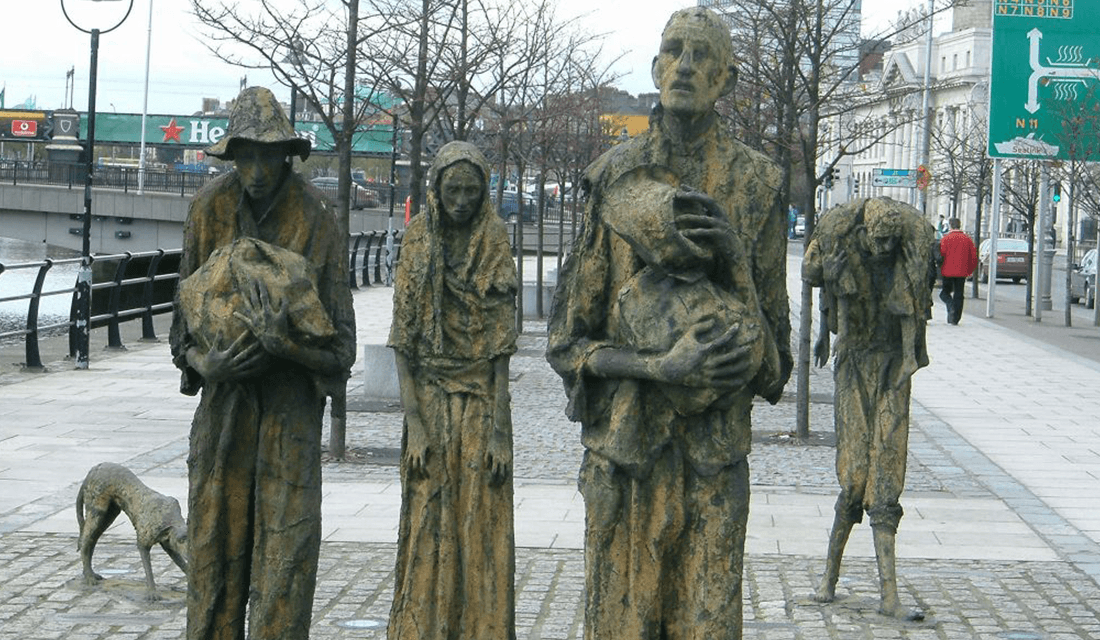
Memorial to the Famine in Dublin | Source: AlanMc/Wikimedia Commons
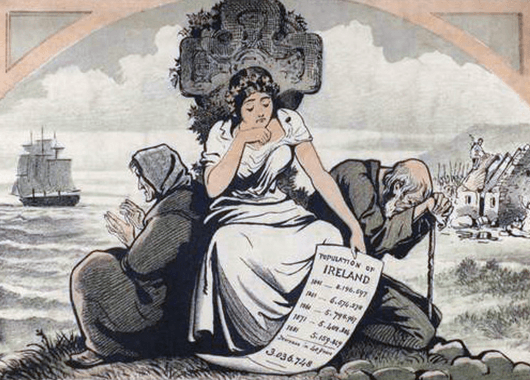
An illustration depicting the devastating effects of the famine | Source: Bodleian Libraries/Wikimedia Commons (CC-BY-4.0)
Moreover, British governance provided little structure for its western neighbors, and the beauty of the countryside was often marred by lawless abandonment. The little rigidity given to British-ruled Ireland was established mostly to support the wealthy, landowning class, whose Protestant faith stood in stark contrast with the Catholicism of the masses, and that boundary was reinforced by centuries of preceding Anglo-Irish conflict. Irish tenants occupied small quarters of land on the vast estates of British landlords. Yet there was little opportunity for the Catholic peasantry to make and manage their own wealth, and on top of the lack of economic pursuit, traditional Gaelic languages and sports were banned from the land. In short, there was little in Irishness to take pride in, and with so much death and loss, there seemed little to salvage.
In the famine’s aftermath, the cultural depletion became abundantly apparent. The populations that suffered most were rural communities, the bastions of traditional Irish living who had cherished what they could of language, music, and sport out of sight of British eyes — and for the first time, English had supplanted Irish as the language of the majority.
As a member of the Gaelic language family — a subdivision of the archaic Celtic tongues — Irish had flourished as the main oral vernacular, spruced by influences of old English and Norman French, with each region on the island brandishing its own systems and dialects. Now, in the wake of the famine, Irish-speaking families had even begun to discourage younger generations from using the old tongue. They equated English, the language of Britain and the United States, with real opportunity, and so many of them discontinued teaching their children. The change in attitude and alacrity toward Irish was drastic.
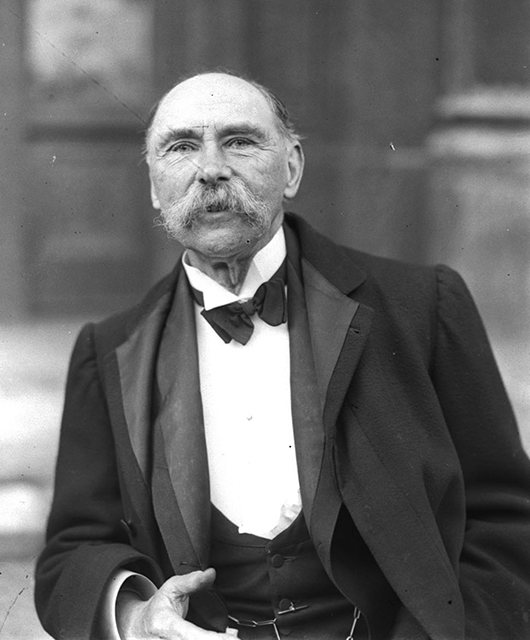
Douglas Hyde | Source: Alchetron
This lack of a uniting, native tongue was likely felt by all who remained in Ireland, but the leaders who took up the cause were largely urban, educated males. Men like Douglas Hyde and Eoin MacNeill — who in 1893 founded the still-existent Gaelic League — devoted their efforts to organizing a sustainable preservation of the Irish language. For decades, similar groups with similar names had formed with similar intentions. The Society for the Preservation of the Irish Language and the Gaelic Union both preceded the Gaelic League, and though these factions splintered and squabbled — much like the nationalist movements that would follow — they were all a response to the same cultural void. Together, they’d noticed how easily a natural disaster like the famine was able to all but raze the native language. Generations of living as a colonized nation provided little resistance to a tragedy that scourged the population, and it seems that while being the great destroyer, the famine was also the great revelation as to how much Irish culture had been strangled.
Through death and dispersion, Irish folk were leaving their island in record numbers. There was no hope to retain the populace; only despair to drive away.
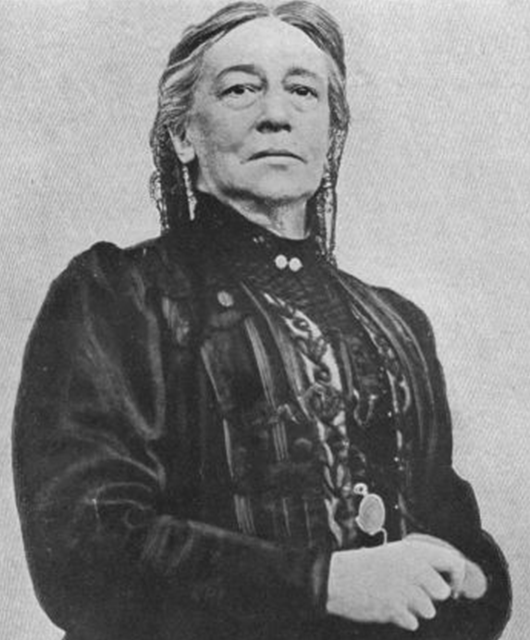
Lady Augusta Gregory | Source: Wikimedia Commons
Literary leagues, too, cropped up to promote the preservation of Irish folklore. Groups like the Ossianic Society and the National Literary Society all promoted traditional Celtic mythology through various plays and poems, and though they drew criticism for translating their works into English, they also answered the culture’s call to arms. W.B. Yeats emerged as a literary titan of the day, though his resistance to learning the Irish language was renowned and often rebuked. He and other creative thinkers of the time threw their efforts behind reviving the culture, including his close friend and confidante Lady Augusta Gregory, a rare but strident female force in the male-dominated circles of Irish society. Together, the two of them injected the themes of old-world mythologies into their works. They published poems, books, and plays, most of which were produced at the Abbey Theatre, which they established together as Ireland’s national theater. Unlike Yeats, however, Lady Gregory — herself one of the landed gentry — did commit to learning the old Irish language, making her presence among patriarchal Irish leadership a pronounced one.
Athletics saw its own reprise as well, spearheaded by men of like-minded circles. Educated leaders like Maurice Davin and Michael Cusack sought to resurrect the Irish sports of old — namely hurling, handball, and Gaelic football — through the foundation of the lasting Gaelic Athletic Association (GAA). Moreover, because these founders were closely linked with the language-revival groups, Irish became — and still is — an integral part of the culture of the GAA. Scattered though they were, and often divided from their rustic peers, these learned leaders wanted to give themselves a home and country to be proud of once again, a country with an unmistakable culture. They wanted a truly Irish heritage, not just a stake in British dominion.
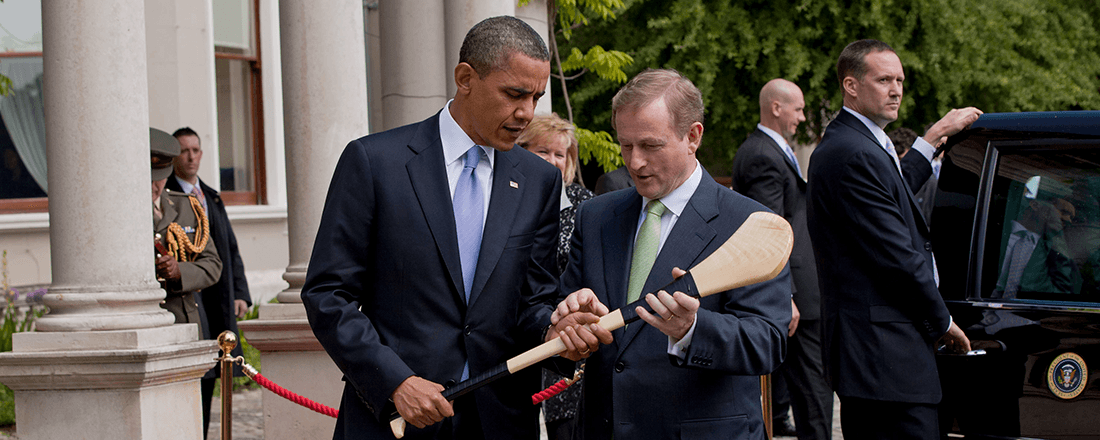
Taoiseach Enda Kenny presenting U.S. President Obama with a hurley | Source: White House/Wikimedia Commons
It should not surprise, then, that these same cultural champions were often the same ones who stoked the nationalist and even independence-minded spirits of their time. Hyde’s Gaelic League attracted future independence leaders such as Patrick Pearse, Michael Collins, and Éamon de Valera, who saw the promotion of the language as an integral part in underscoring the want for a free Irish state. Pearse himself founded a school built on instructing young men in the old tongue, men whom he instilled his own nationalist ideals in. As these names were closely associated with the propagation of the Irish language, so, too, were their causes. This newly revived Irishness, with its adherence to language, literature, and sport, became inseparable from the conflicts of 1916, the War of Independence, the Civil War, and the troubles between Northern Ireland and the Republic that brewed for decades. Yet, like the conflicts themselves, the culture’s power to unite was denigrated by the division of its proponents.
The struggle for Irish independence was a notoriously fractured one, with laborers of the country viewing it as a struggle for the working man, urban elite seeing the cause as one of national pride, and even the religious Catholic wings looking to Ireland to champion the church. How each of these factions viewed the struggle informed how they viewed the language. Divided, Irish didn’t stand a chance against English. As a reprise, the language simply couldn’t resonate as strongly as it might have with a unified force of proponents, as clergymen spoke of Irish as the language of prayer, rural communities still adhered to its practicality, and learned urbanites took stock of its symbolic value. For an island nation so small, the fissures in outlook ran wide. Six counties still fall under British rule today.
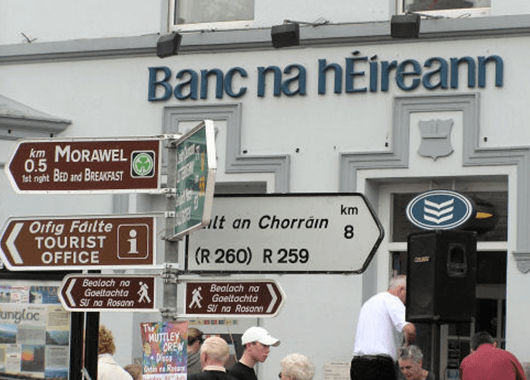
Signs in Irish | Source: Kenneth Allen/Wikimedia Commons (CC-BY-SA-2.0)
Yet Irish carries on as a language, despite the paucity of its speakers, and the variations of Irish society have made themselves known in the different ways it’s taught and spoken. In the remote communities of the rural west, pockets of fluent Irish speakers still thrive and conduct their everyday business in the old tongue, and they distinguish local dialects with all manners of linguistic monikers, including spelling, syntax, and accent. The sheer geography of these minuscule clusters has managed to insulate their linguistic traditions despite the drastic decline in the number of speakers. Meanwhile, every Irish pupil is required to learn a more systematic version of the language through the secondary-school level, one that aims to unify all the native dialects into one accepted standard that is funneled into education and all things official.
Out of all these hallmarks, language became the common thread in the new nationalism.
However, each child’s foundation of Irish in education hinges entirely on the instructors they encounter, and few report a truly uniform experience. Moreover, students in urban communities tend to assume the mindset that Irish is a hallmark of strong education rather than a strong communicative tool, thus propagating a divide that has always plagued the reprisal. Another feature of this difference in Irish living is the fact that many Irish students spend part of at least one summer away in Irish-speaking areas known as the Gaeltacht. Though the experience is meant to enrich their appreciation of Irish as a language and integral part of their culture, it also removes them from their normal circumstances, and Irish itself is reinforced as something not normal.
Still, the language reprisal has made an undeniable stay in recent Irish history. Furthermore, the fact that most of that recent history was rife with violence, conflict, and poverty speaks to the will of those who’ve seen to its survival. Recent decades have seen Ireland became steadily less divided than it used to be. Free movement of the citizenry exists between Ireland and the U.K., two nations who exchanged great bloodshed for most of the 20th-century. The goodwill that now exists in their relationship only serves to improve the sentiments of Irish nationals toward Britain and, by consequence, further unite them. The economic boom in the 1990s known as Celtic Tiger saw waves of immigrants enter a country typically known for its high levels of emigration. Now, the Irish economy has become drastically more globalized, with major corporations like Google, Facebook, and Apple stationing their European headquarters in the low-tax zones of the Irish borders.
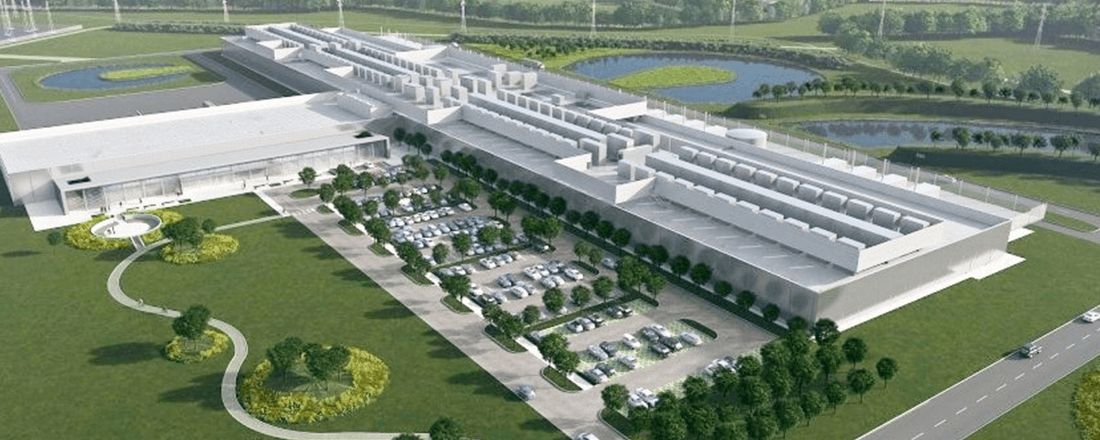
Facebook’s Proposed Data Center in Ireland | Source: Power Engineering International
As a result, Ireland’s presence has become more internationally minded, and so have its people. Even the relations between the Catholics and Protestants of Northern Ireland have drastically improved from the brutality they once inflicted on each other, and today they hold debate over institutionalizing the Irish language, a once unfathomable idea. The signs of a steadily more unified, more modernized Ireland are in place. Though only about 30% of the population even report using Irish at all, the numbers are statistically on the rise, and the future the language takes will reflect the country’s own, weaving in and out of use, intent, and structure just the way the people navigate what life in Ireland means.
With Ireland becoming more united, porous, and globally involved, perhaps it’s not too unimaginable to foresee a future where a stronger base of the language at home will equate to its further movement abroad, or even to influential development from other tongues. Irish already holds a place on platforms like Google Translate and language-learning software like DuoLingo and Rosetta Stone. As a system of communication, it tells the story of modern Ireland, the story of a great reprise. How strongly it resonates in the future will depend on how strongly Ireland continues to unite on its new path.

